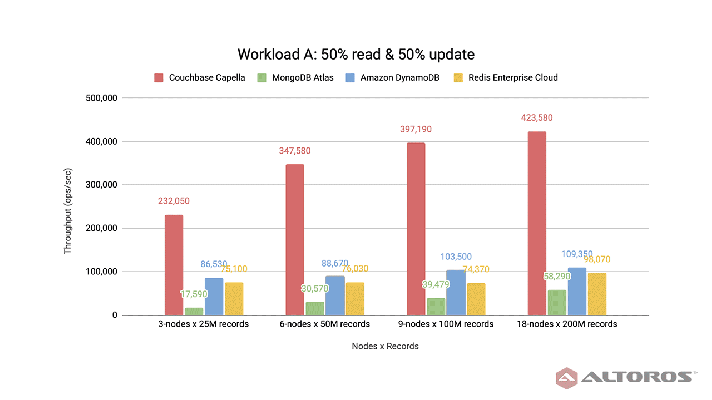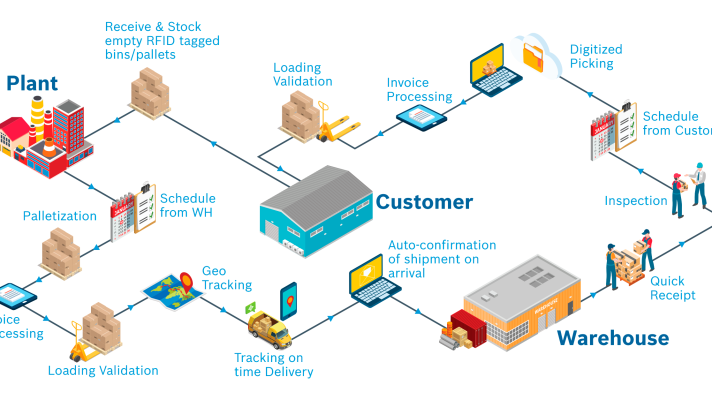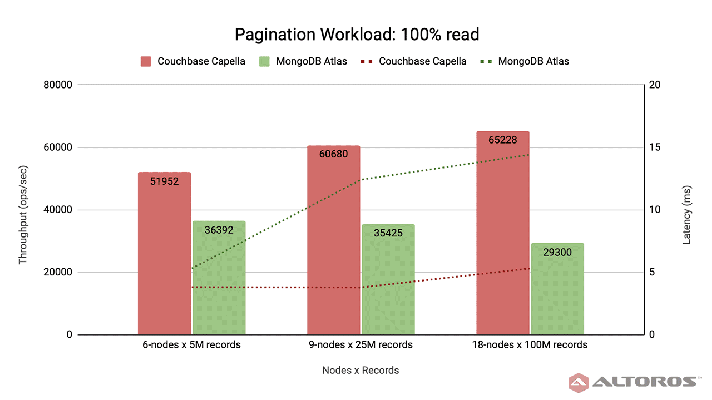How to Optimize ROI Using Remote DBA and Avoid the Most Common Mistakes
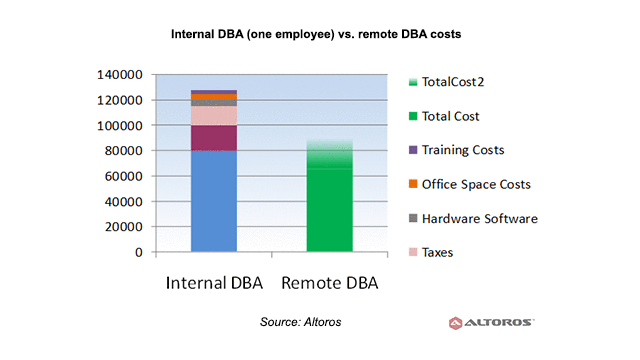
Executive summary
Studies demonstrate that relational databases grow 3x to 5x in size every three years. Enterprises manage a growing number of databases containing more data with increasingly high requirements for uptime and security. In order to maximize return on investment (ROI), companies are challenged to supplement their IT teams and re-balance their development priorities.
The soaring amounts of work are becoming harder and harder for database administrators to deal with, and eventually employing new personnel seems inevitable. The reality is, trying to keep up with the progress by employing more programmers is often not the best solution available.
One possible solution to the problem is remote database administration (DBA). Depending on the scope of work, it can help cut DBA expenses by 40% or more without sacrificing reliability, uptime, or the security of data.
This article will show why remote database administration is financially beneficial and explain how to plan, design, and manage remote DBA initiatives and avoid the most common mistakes.
Why remote DBA?
Providing infrastructure for data storage and management, databases have grown to be a critical component of companies from mom-and-pop shops to Fortune 500 companies.
Most of a DBA’s workday is spent on repetitive, low-level administrative work, whose ROI is fairly low.
Often, small and mid-sized companies underestimate the role of their relational databases until they run into problems.
Safety is not the only concern when it comes to database administration, though. Generally speaking, most of a DBA’s workday is spent on repetitive, low-level administrative work, including such tasks as checking alert logs, monitoring performance logs, tuning, applying patches, performing upgrades, installing agents, validating the backup and recovery process, following change management procedures, and addressing requests from applications developers, O/S administrators, and end users. These tasks are certainly critical to database maintenance, but, ironically, while playing a crucial role in the support of an enterprise’s infrastructure, they do not relate directly to a company’s core revenue-generating competencies. The return on investment of employing internal database administrators, therefore, is fairly low.
Relying on remote DBA is advantageous in both of these aspects. On the one hand, it guarantees your data is safe, since taking care of databases is the direct competence of a remote DBA server provider. This means no unexpected expenditures caused by security issues. On the other hand, remote database administration is beneficial financially, ridding the enterprise of such a considerable, yet cost-ineffective expense as keeping internal DB administrators. Depending on the amount and specific character of work, remote DBA can help cut DBA expenses by 40% or more.
Another huge benefit of remote DBA is round-the-clock database monitoring. 24×7 support is rarely feasible for an enterprise’s in-house staff, both from logistical and cost positions. At the same time, it’s often necessary, particularly for companies that provide a 24-hour interface with customers via the Internet. Remote DBA service providers make this possible.
Internal DBA: hidden costs in your cost structure
Before companies can start saving on DBA work, they should run the numbers to realize how much they are spending. Studies show that not many companies can assess the total cost of internal database administration correctly.
What most enterprises fail to realize is that there’s more to DBA than just the salaries of the staff involved in the administration process. Estimating the total cost of DBA requires knowing more than just that. To be able to estimate the total cost of database administration, it is important to identify all of the costs that comprise it.
Apart from the most obvious expense—salary—there are a number of less obvious, or hidden, costs. Most importantly, these are benefits and pay increases, which contribute to the total cost quite considerably. More than that, taxes should also be taken into account, as well as the office space costs.
Typically, for a newly hired database administrator, training is also required.
Although there has been a consistent trend of hardware and software costs going down, they are still an expense to consider. Personnel costs (such as the above-mentioned salary, benefits, and pay increase costs), by contrast, seem to be continually rising. As their share in the total cost exceeds hardware and software costs, the expenses of an enterprise that employs an internal database administrator are increasing, too.
The structure of internal DBA costs, therefore, looks like this:
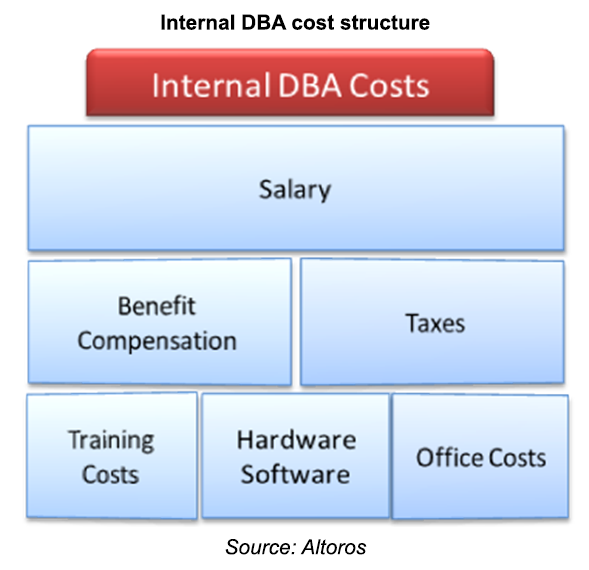
Internal DBA cost structure
Keeping all these factors in mind can help an enterprise form a more objective view of the total costs of internal DBA.
ROI: internal vs. remote DBA
If a business component does not generate revenue, the ultimate way to improve its ROI is to cut its costs. Let’s see how much, exactly, internal DBA costs, and check whether switching to remote database administration can help an enterprise save substantially.
We will estimate every one of the elements that comprise the total cost of internal DBA:
| Salary | Salary is, naturally, the biggest internal DBA expense for an enterprise. On average, reaching about $80,000 per administrator annually, monthly salary costs come to $6,700 for each DBA employed. |
| Benefit compensation | The second largest DBA expense of an enterprise, benefit compensation, typically reaches about $20,000 yearly. |
| Taxes | With one internal DBA contractor implemented, an enterprise can normally expect its yearly taxes to rise by $15,000. |
| Software and hardware costs | Software and hardware expenses can be quite different depending on the database solution used and the desired hardware characteristics, but enterprises should budget at least $5,000. |
| Office space costs | Just like software and hardware costs, the costs of renting office space for an internal database administrator could vary, but typically in the US office space for one DBA costs about $5,000 a year. |
| Training costs | The initial training costs of a database administrator are estimated at approximately $3,000. |
The total cost of an internal DBA, therefore, comprises about $113,000 a year for one administrator. Typically, one database administrator is employed per every 20 relational databases, so companies that operate a larger number of databases can spend about $226,000 or $339,000—or more on internal DBA.
Remote DBA costs vary depending on the service provider, and complexity and scope of the work. Most service providers charge on average about $65,000–$90,000 annually. Of course, if the number or size of databases is uncommonly big, or if additional features are being implemented, the amount could increase—just as the spending on internal DBA would.
Enterprises can save up to 45% of their spending on DBA by relying on remote administrators instead of one internal employee, and even more if there are two or three internal administrators.
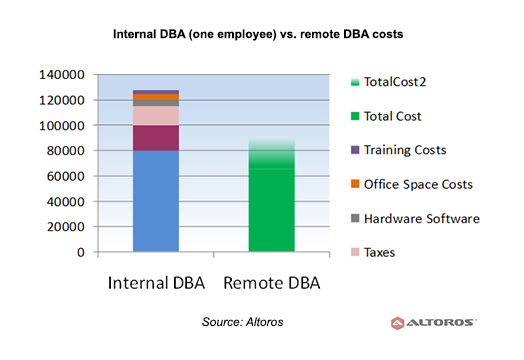 Internal DBA (one employee) vs. remote DBA costs
Internal DBA (one employee) vs. remote DBA costs
Common mistakes
These are the mistakes made by remote DBA service providers.
- Avoiding responsibility. A service provider is always fully responsible for the service implementation process. Some service providers try to avoid legal accountability for their work, since this protects them from many risks. Enterprises should keep in mind that such policies also deprive them of their rights to claim indemnity for any deviation from the remote DBA process, should it occur.
- Referring to an intermediary. The relationship between a client company and a remote DBA service provider, in a sense, is very intimate. You can’t defer to a third party to manage such a relationship. Sometimes, as soon as a deal is signed, a managerial team, different from the remote DBA team, takes over the relationship. This is undesirable as long as you want to maintain contact with the remote DBA team itself—and you normally do, since they are the ones who do the job and who you have employed to do it.
This is the list of the most common pitfalls of the client enterprise.
- Inadequate readiness assessment. It is critical that an enterprise’s readiness is assessed adequately, the choice of the databases to be outsourced is weighed, and the strategy of remote DBA is well thought-over and accepted. If these conditions are not fulfilled, outsourcing database administration can be more of a hassle or even a threat to an enterprise’s database’s effective functioning than its catalyst.
- Unrealistic cost expectations. Remote DBA is cost-effective, but one has to be rational about the extent of economy it guarantees. For several years now, the business press has been claiming that IT work costing $50–$80 an hour in the United States can be done for $20–$35 an hour in India or Russia. If these numbers sound too good to be true, that’s because they usually are. IT executives should expect to pay an additional 5 percent to 15 percent on managing an offshore remote DBA program, at least during the first year. The transition phase will add costs, too: planned expenses should cover diligence, transfer of knowledge, and extensive program management.
- Relying too much on executive contact. Once a company has decided to outsource the administration of its databases, usually there is a rush to get the deal done and put the transaction on the fast track. To do so, executives from the company and the outsourcer meet, agree, and leave sorting out all the details of such a relationship to the management phase of the deal. Yet, it is advisable that more of the enterprise’s human resources be involved in these initial meetings and have a say in the agreement; just the top-level executives are rarely enough.
- Not letting the remote DBA team lead the process. In trying to lead the database administration process, enterprises forget that when outsourcing it, they, basically, chose to shift this job onto a third-party team. A client company should be aware that with any outsourcing, it passes the job-to-be-done to a service provider and then buys the job-that-is-already-done from this provider, and the surest way to break the relationship is by dictating how this job is to be done.
- Signing a deal with too long a term. The longer the contract terms, the deeper a company gets in it. Building up a long-run strategy is important, but on the other hand, if a long-time deal is clinched, it absolutely should allow for changes to the agreement terms over short periods of time. It is generally considered even better for an enterprise to develop a close relationship with an outsourcing company, but sign a short-term contract that can be easily negotiated and, if necessary, renegotiated or even broken.
- Improper process management. It is a mistake to assume that once all the details of a remote DBA deal are discussed and the contract is signed, you do not have to worry about database administration any longer. A person should be assigned to manage the process. The right person for the job is someone who understands the process and is able to focus on the results that best match the interests of the company. He or she should also have the foresight to recognize any possible problems before they actually occur.
- Treating the outsourcer as an outsider. Far too often an enterprise forgets that the remote DBA service provider is a business asset and must be treated as such. A remote DBA team is a vital part of a successful business, and it should be treated accordingly, not as one of the many suppliers, etc.
Some remote DBA teams propose costs that are half as costly as employing a full-time DBA, but it’s not rare that the lower cost is made up for by poor service.
Benchmarking remote DBA: when and why
When an enterprise decides to switch to remote DBA, it typically expects that doing so will help to save a sizable part of the budget previously allocated for database administration. While generally the financial benefits of remote DBA are beyond doubt, it is a mistake for an enterprise to think that just clinching the deal guarantees savings. Although some remote DBA teams can propose costs that are half as much as employing a full-time database administrator, the true price of these cost savings is generally poor service. Benchmarking is required to provide a baseline of costs and service levels. An enterprise can use it to compare the results delivered with the results within the industry, and consequently negotiate or renegotiate the outsourcing deal.
When negotiating, benchmarking knowledge ensures that adequate expectations are set for cost, performance, and the quality of service. When an enterprise has decided to switch to remote DBA and does not intend to carry out a painstaking investigation—wishing instead to move on through the negotiations quickly—benchmarking data can be used as a guide.
Once a deal has been settled, benchmarking can be used for contract refinement. Most outsourcing contracts are renegotiated within two years of being signed. The main reasons for renegotiation are typically dissatisfaction with cost or service quality. Referring to benchmarking data is the main way to make a case with the remote DBA team when renegotiating the contract.
This is why it makes sense that the requirement for benchmarking be included in the final terms of a remote DBA contract. In this case, one can expect that realistic expectations help to bring about a positive outcome.
Further reading





